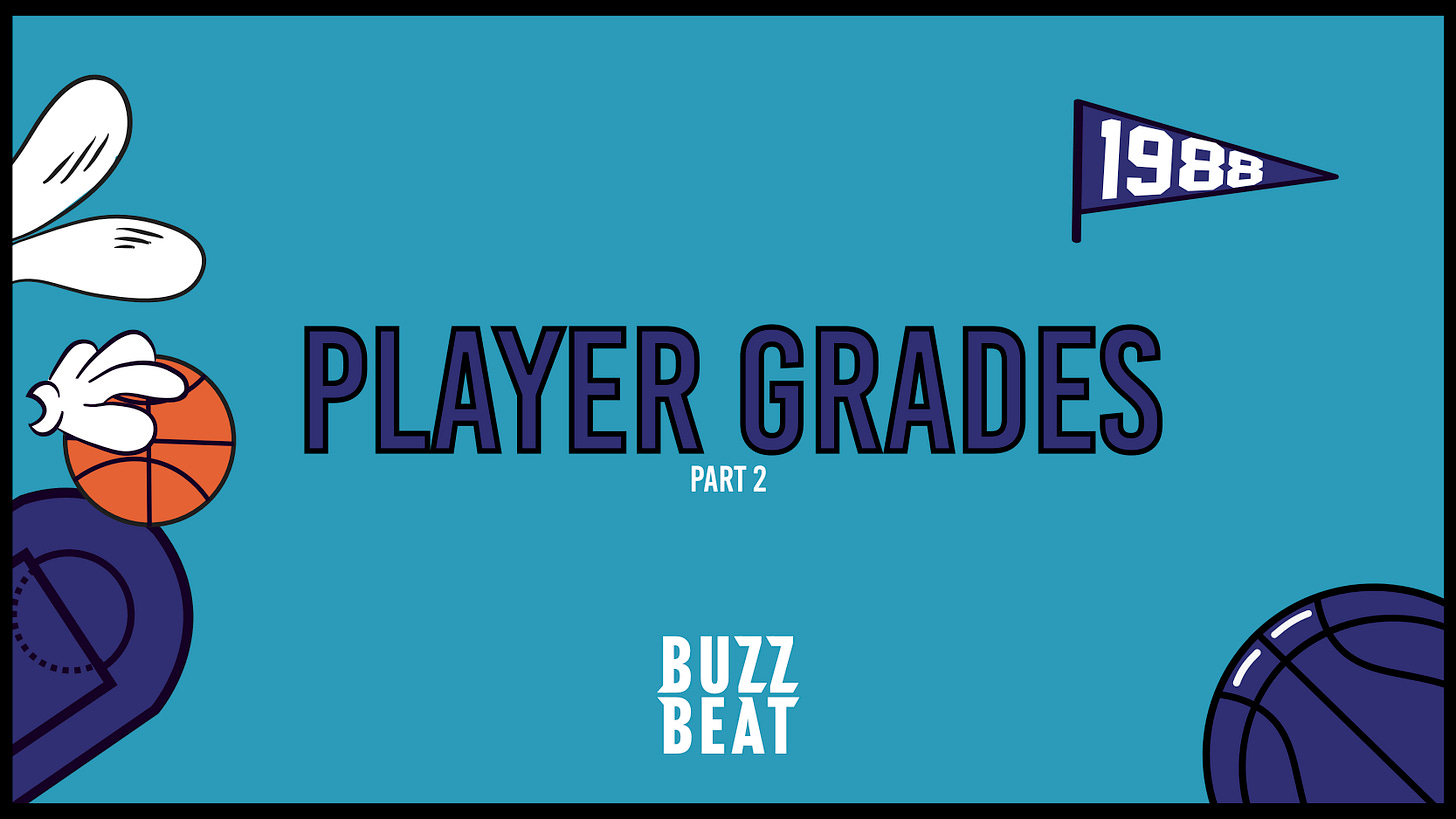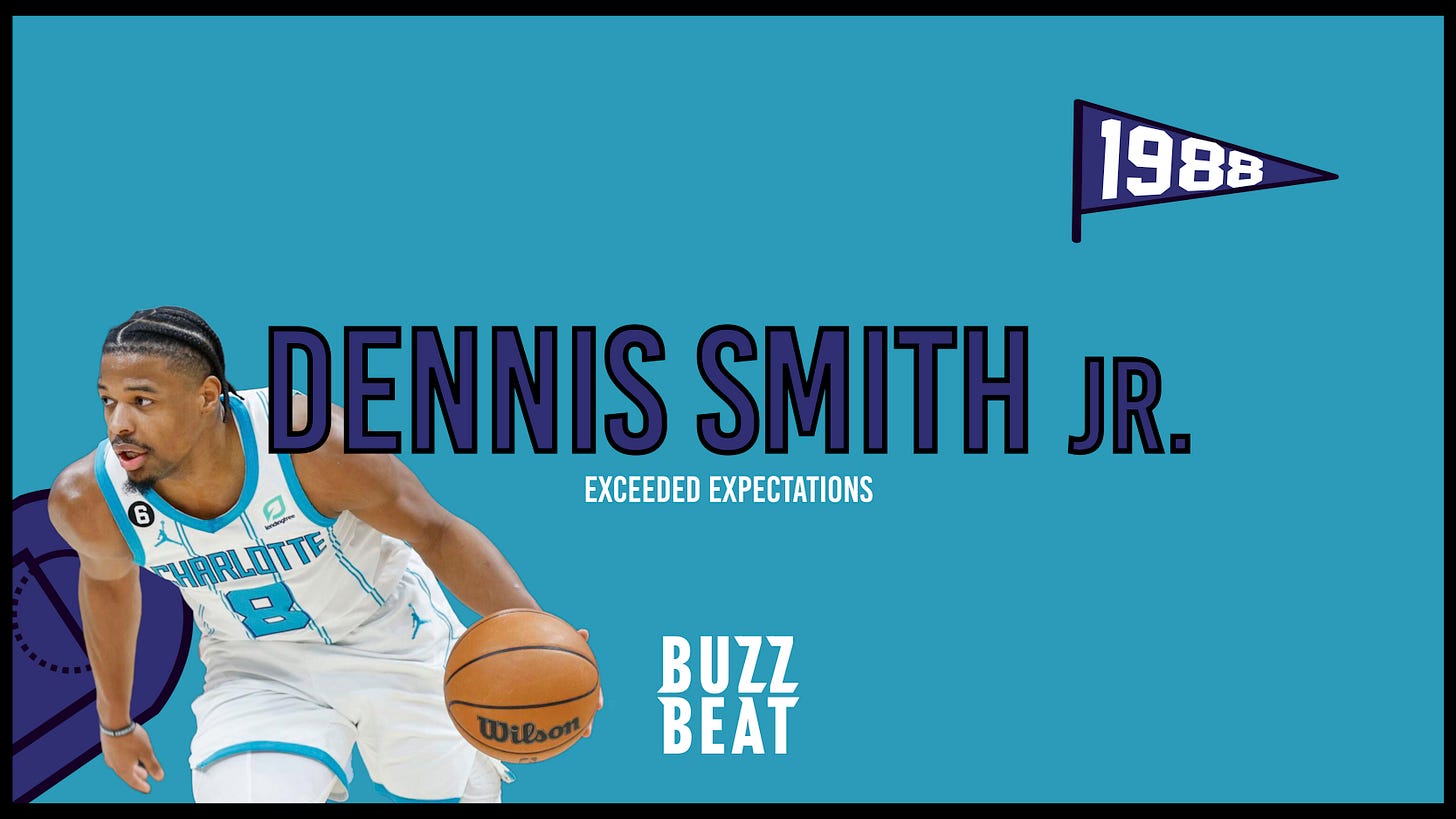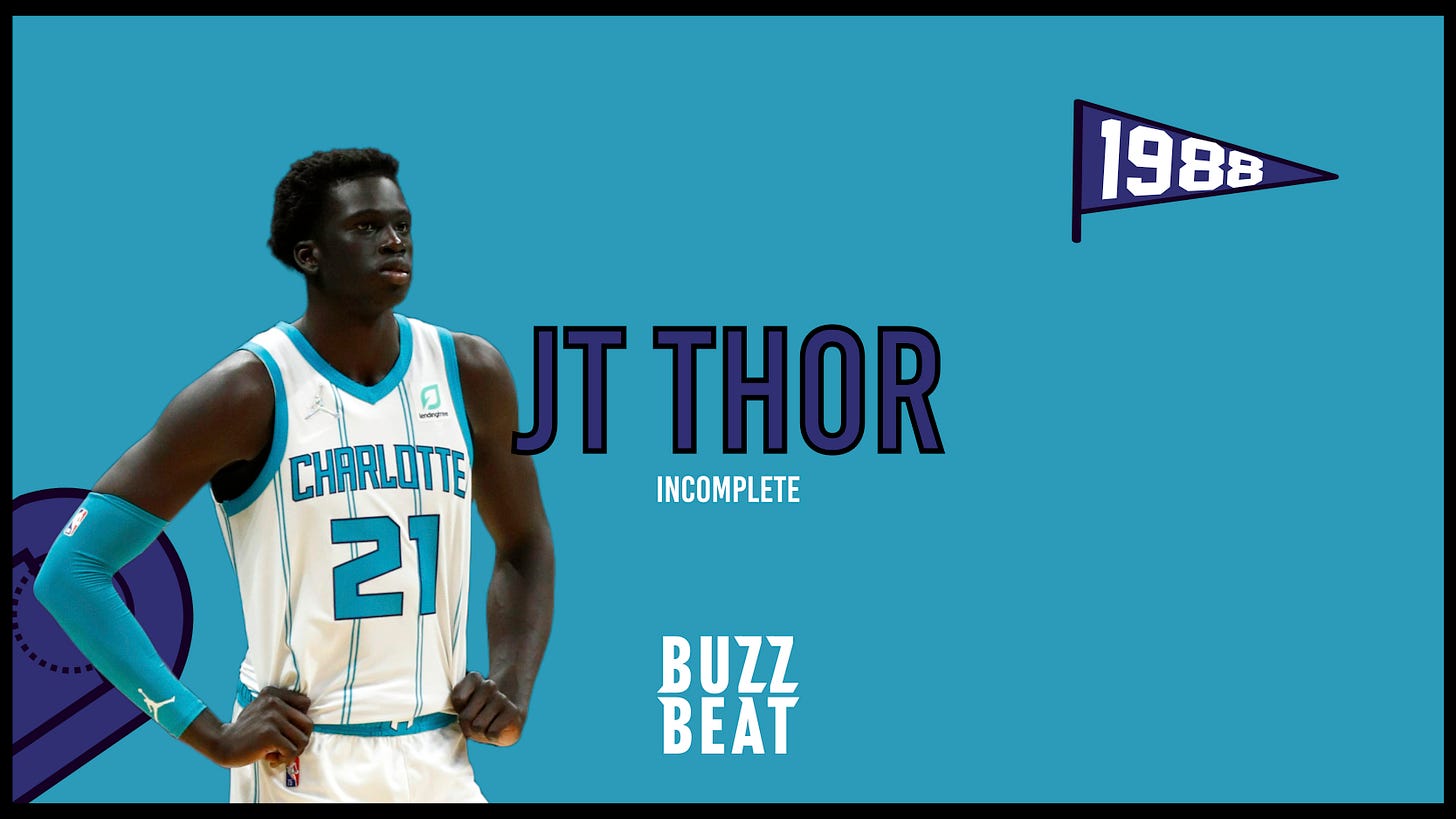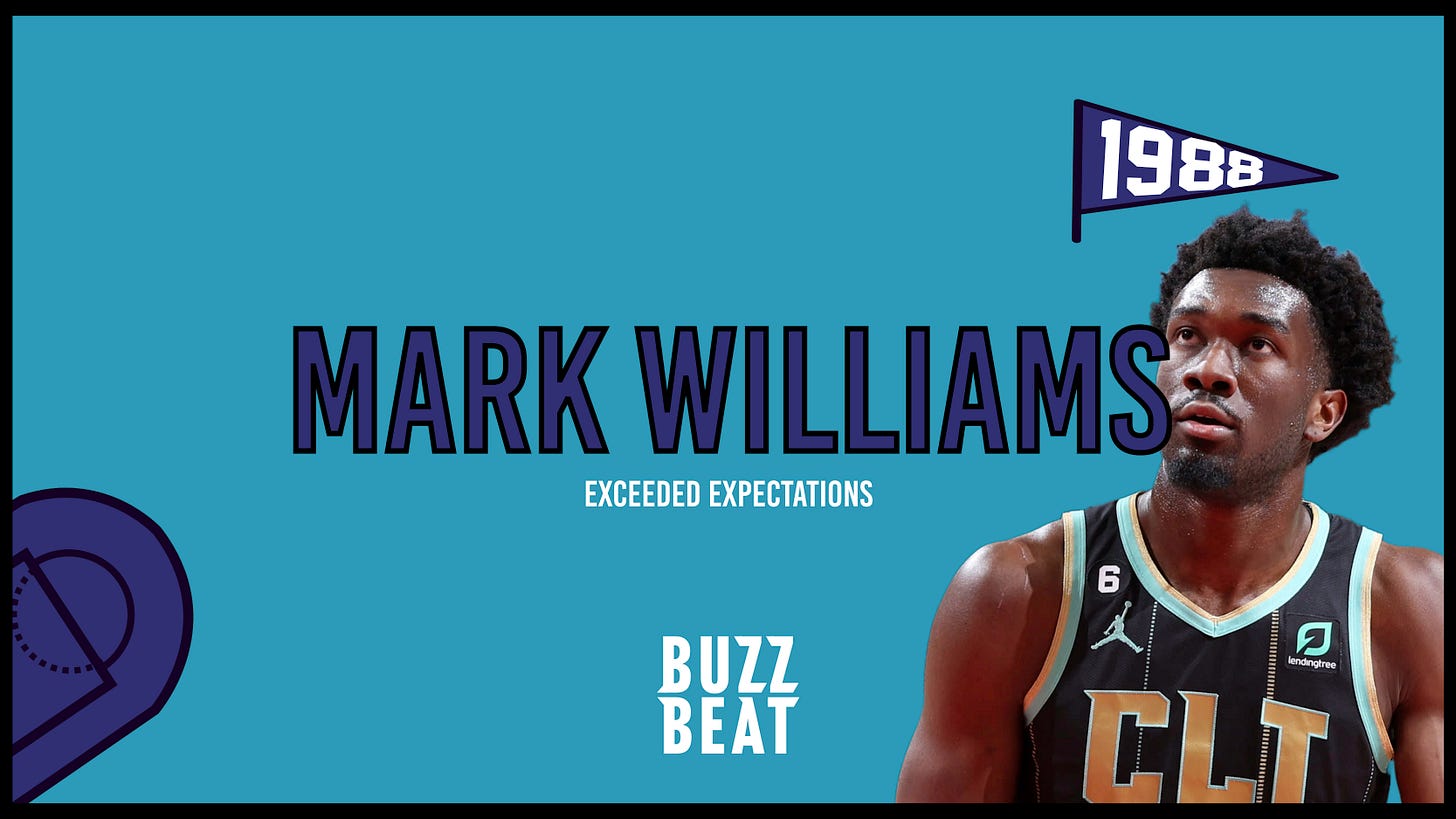Player Grades | Part 2
What Went Right, What Went Wrong
This is Part 2 of my “Player Grades” series. It’ll be out in full for everyone tomorrow (April 14). If you are a Buzz Beat+ subscriber, please enjoy today.
If you missed Part 1, check it out here.
The 2022-23 season for the Charlotte Hornets couldn’t have ended sooner for most fans. The team finished with a 27-55 record and sights have been shifted to the NBA Draft Lottery.1
Having said that, reflecting on the season and noticing how players have performed is always good practice. I’m going to take a look at some of the “prominent”2 players on the Hornets, what they did well, and what they could’ve improved upon.
Instead of handing out letter grades, I have composed my own scale for measuring the performances of these players:
EXCEEDED EXPECTATIONS3
MET EXPECTATIONS
FAILED TO MEET EXPECTATIONS
INCOMPLETE
Terry Rozier
Context plays a large role in everything, but it’s hard to get too excited about Terry Rozier’s 2022-23 season. The injuries forced him to play out of position for larger chunks, but he never got things going from behind the arc and regressed from the midrange — an area in which he started to develop since coming to Charlotte.
“Terry had a good year. Terry’s numbers are very misleading because his numbers when he got to play with both ‘Melo and Gordon – his three-point shooting, and his two-point efficiency – were really good. He just had to play so many games where he’s the primary scorer, he’s guarding the other team’s best player and they’re double-teaming him every time we needed to score, so that hurts what his numbers would look like.”
Steve Clifford, April 10
Rozier is best suited as an off-ball mover that can create gravity by pulling opposing defenses in his direction. To enhance that, you also need individual players that have productivity in getting into the paint and scoring at the rim at will. The Hornets lost their best player in that department last summer.4 Having said that, there are still other ways you can leverage paint pressure to open up looks for outside shooters and Charlotte still found ways to do that.5 Rozier shot just 32.7% on three-point attempts, his lowest since his second season in the NBA.
His midrange floater and jumper were neat developments in his previous two seasons in Charlotte. It gave him a counter to when teams ran him off the line or when he was tasked with point guard duties. He can weave to his spot in the midrange and find touch in both the short and long midrange spots. This season he converted on just 40% of his attempts in the short-midrange and 42% of shots on two-point attempts of 14+ feet.6
Relatively speaking, Terry Rozier was one of Charlotte’s most available players and that has to be a point in his favor. Also, with an increased role and usage, he did a fine job of not turning the ball over. And defensively, he still had his moments navigating off-ball screens and jumping passing lanes.
With media on Monday, Steve Clifford was much more positive about Rozier. At the end of the day, he just didn’t have the influence that you were used to seeing in his previous seasons with the Hornets.
GRADE: FAILED TO MEET EXPECTATIONS
Dennis Smith Jr.
The late acquisition of Dennis Smith Jr. seemed like an afterthought and likely tempered expectations for the backup point guard. The moment he stepped on the court though, his impact was felt on both ends. The Fayetteville native was one of the better stories to come from the ‘22-23 Hornets.
Let’s briefly get the flaws out of the way before gushing about his strengths. Smith Jr. was inadequate as an outside shooter. Opponents didn’t respect his three-point shot as he hit just 24 of his 111 attempts from behind the arc. Offensively, he was limited in what he could do and Clifford needed the right personnel around him to make the most out of his minutes.
His aggressive nature in collapsing the defense was the perfect way to compensate for his lack of spacing.7 While he was a slightly above-average rim finisher, his driving wasn't primarily used to get him a bucket. He was very good at getting downhill to find teammates.8 The team also increased their corner three-point efficiency when he was on the court, a good indicator of successful drive-and-kicks.
The most glaring effect that Smith Jr. had on this team was the presence on the defensive end. He locked up opposing point guards, used his strength to keep would-be drivers out of the lane, and was an absolute pest getting his hands in passing lanes. His activity also showed up with his ability to get out to shooters and contest shots.9 Without a doubt, he was Charlotte’s best player on this end.
GRADE: EXCEEDED EXPECTATIONS
JT Thor
Depending on when you watched him, JT Thor could’ve looked like a G-League player or a steady rotational NBA player. It was a tale of two halves for Thor and luckily for him, he ended on a high note. His skills are still raw but he started to show some life following February’s All-Star break.
Thor’s calling card is on the defensive end of the court and because of his current size, is better suited on the perimeter. Regardless of any physical limitations, he competes on this end, chasing players all over the court, contesting shots, and rotating as a help defender. While he’s not going to body players out of the restricted area, he occasionally will end up with a block because of his positioning and length.10
The offensive side was less consistent and we can look at the All-Star break as a line of demarcation. There were moments earlier in the season when JT Thor looked unsure of himself on the court, hesitating on shots or turning the ball over. His shooting from all over the court was completely inefficient.11 It was like a switch went off following the "midseason" break. In the final 22 games, Thor's two-pointers stayed relatively steady but it was his three-point efficiency that took off. It increased from 25 to 38% and he ended the season on a streak of 14 games with at least one three-pointer made.
Right now, Thor is limited on offense. He’s a low-usage guy that makes his biggest impact as a catch-and-shoot three-point shooter. He’s not developed a game with the ball in his hands, he doesn’t get all the way to the rim12 and needs to get more involved as an off-ball cutter. The coaches have praised him for his work ethic and hopefully, that’ll go a long way in filling in some of these gaps.
GRADE: INCOMPLETE
P.J. Washington
Availability is a skill, especially in 2023 when Charlotte players were dropping like flies.13 P.J. Washington played in a team-high 73 games, missing just 8 for injury and another for personal reasons. The absence of his teammates opened up opportunities for him to shine in other departments on the floor.
When you think of this soon-to-be restricted free agent, you think of a guy that can play through pick-and-pop situations and slide across multiple positions when on defense. This skill set has stayed fairly consistent in his four seasons.
With the heavy lifters in and (mostly) out of the lineup, Washington showed some promise with the ball in his hands this season.14 While plenty of room for improvement, his capability to handle the ball, attack the paint and hit floaters, and make passes out of a variety of situations instills hope that he doesn't have to be pigeonholed as the fourth or fifth option. And if he's not initiating offense through self-creation, the offense should — at the very least — involve him as a screener where he can feast as both a floor spacer and roller.15
Other than rim-finishing and lackluster rebounding numbers, there aren’t many weaknesses that jump off the page. In the same breath, it seems he goes through lulls where his impact can barely be felt. He just might be one of those players that needs everything around him to be clicking for his best self to show on the basketball court. And if that’s the case, is he worth $20 million?
GRADE: MET EXPECTATIONS
Mark Williams
Playtime for the first-round pick took a while to solidify, but once it did, Mark Williams never looked back. Many (myself included) were hoping the 15th overall pick would be more of a mainstay in the rotation from the jump but the play of Mason Plumlee and Nick Richards prevented that from taking off.
Williams came in and immediately provided an impact as a pick-and-roll big. His sheer size and wingspan make any partnership with a guard a dream. He’s very good at sealing his man for positioning in the paint or providing vertical spacing if he’s on the move.
At the moment, his biggest impact is on the defensive end of the court. The obvious place to start is with his rim defense. He blocks 2.2 shots per 75 possessions and opponents are shooting 3.5% lower than expected on defended rim attempts.16
He's surprised many with his ability to switch up coverages in defending the pick-and-roll. Coming into the season, the consensus was that he'd be a traditional drop center.17 While he's not actively switching, there have been instances of Williams coming to the level of the screen or one step below. For this to be effective, Williams has to be semi-nimble in preventing the ball-handler from taking it to the rim and he's done just enough in this category. And because he’s agile enough to get good positioning, he stays within striking distance of steals. His length helped him accumulate 1.2 steals per 75 possessions.
Williams should be penciled in as the starting center next season. Strides will need to be made in passing out of the pick-and-roll as defenses like to blitz LaMelo Ball. He could also use a little more touch on his midrange shot, but that will certainly come with time.
GRADE: EXCEEDED EXPECTATIONS
🐝 Thanks so much for reading and supporting the podcast. If you like what we do, we’d really appreciate it if you could please give us a rating and review on Apple Podcasts.
The NBA Draft Lottery will be held on Tuesday, May 16 where the first 4 overall picks are randomly awarded and the remaining slots are sorted by team record.
I’m using an 800-minute minimum for my arbitrary threshold.
You are probably wondering, “Whose expectations?” Mostly mine, but also what should be expected of players based on draft position, role, experience in the league, previous seasons, etc.
If you were wondering, that player is Miles Bridges.
The Hornets were 12th in the NBA in paint touches and 13th in frequency of plays using a roll-man. Both are indicators that Charlotte still had an objective to get rim pressure.
Rozier converted 43% in the short midrange and 47% in the long midrange in 2021-22.
Smith Jr. averaged a robust 9.2 drives in 26 minutes per game.
Smith Jr. had a 50.4 pass rate out and a 13.9 assist percentage off his drives.
Smith Jr. contested 2.3 three-point attempts and 2.4 two-point attempts per game.
Thor finished with a 2.1 block percentage and was 4th on the team in blocks per 100 possessions (minimum 800 minutes).
Pre All-Star break, Thor shot 59.3% at the rim (higher than post-ASB), 44.4% on short-midrange attempts, 25% on long-midrange attempts, and 25% on three-point attempts.
Thor only averaged 2.75 rim attempts per 100 possessions (the only two lower were Sneed and Simmons).
The players on the Charlotte Hornets missed a total of 268 games according to Spotrac, the 4th highest number in the league.
Look no further than March 28th’s game vs. the Thunder where Washington dropped 43 points and only 36% of his two-point attempts were assisted on.
Washington scored 1.28 points per possession as a roll-man on 55% shooting.
This stat attempts to measure what players would shoot on rim attempts (above or below) and what is expected based on shot locations. Williams’s number is good for the 85th percentile.
Drop coverage is where the center is multiple steps behind the screen containing both the ball-handler and roller. This can be susceptible to pull-up three-point attempts.








Part 3 coming soon?